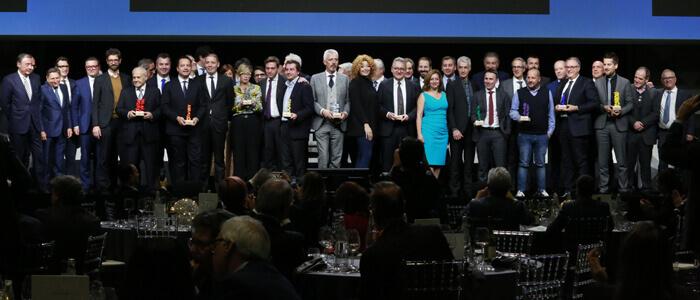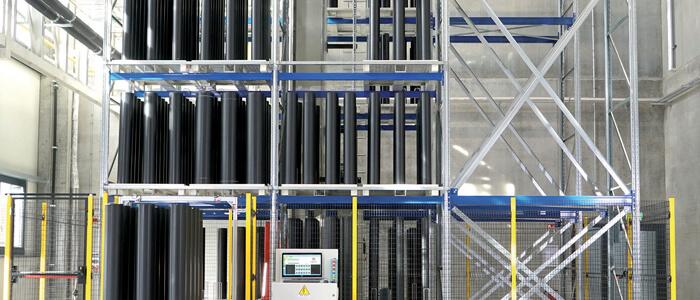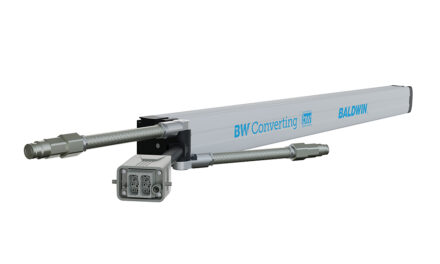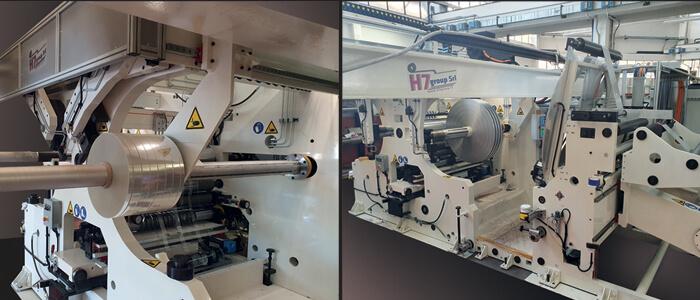Italian excellences: the winners of the 2019 Print Oscars and the first Print Economic Forum on stage at Palazzo Mezzanotte, home of the Milan Stock Exchange.
Eleven awards to celebrate eleven excellences in the Italian printing world. Wednesday 4 December, in the Parterre room of Palazzo Mezzanotte – the historic headquarters of the Milan Stock Exchange, fronted by Cattelan’s irreverent and unavoidable “middle finger” – the 28th edition of the Italian Print Oscars was held: the event created in 1987 to award companies in the graphics industry which each year stand out both in terms of results and management. Presenting the evening Enrico Barboglio, CEO of Stratego Group and member of the jury that last October chose the winners from among the candidate companies, and Laura La Posta, journalist of Il Sole 24 ore.
Categories and winners 2019
- Entrepreneur of the year to Emilio Albertini of Albertini Packaging. Sponsor Heidelberg
- Best technology innovator to ACM. Sponsor Konica Minolta
- Best finishing and special supports to Labe. Sponsor the Cordenons Group
- Best label to La Prensa. Sponsor Gallus
- Best digital printer to Leaderform. Sponsor HP
- Best paper converting to Arti Grafiche Turini. Sponsor Koenig & Bauer
- Best converter to Nuova Erreplast. Sponsor Converting Magazine
- Best wide format printer to Sismaitalia. Sponsor Wide Magazine
- The Industry 4.0 printer of the year award went to Istituto Poligrafico Zecca dello Stato. Sponsor Federazione Carta e Grafica
- The Graphic industry of the year award went to Chinchio. Sponsor Printgraph
The winners of this edition were designated by a jury comprising nine members: Enrico Barboglio, CEO of Stratego Group; Renzo Callegari, production consultant at Cheil Italy; Valentina Carnevali, chief marketing manager of Stratego Group and general secretary of DMA Italia; Fausto Ceolini, business consultant for Industry 4.0; Luca Fiammenghi, professor of advanced graphic techniques at the Milan Polytechnic; Stefano Lavorini, director of the magazine ItaliaImballaggio; Franco Martinetti, art director; Giuseppe Peccati, founder of Asso Prod and Event management collaborator; Marco Sachet, industry expert.
One hundred years of printing ought to be rewarded!
Furthermore, this year the organization has decided to introduce a new award, dedicated to companies that celebrate an important anniversary: Their centenary. The first Special Award “One Hundred Years of Printing” went to Grafiche Nappa, a company that has undergone various process transformations and product changes to maintain its role of excellence in a constantly changing market. The motivations behind the awarding of the prizes, photos and videos of the evening will be published on the website oscardellastampa.
Print Economic Forum: economic observatory, success and critical factors of Italian companies operating in the printing and converting sector
The first Print Economic Forum sponsored by the Club of Excellence of the Italian printing industry was held on the afternoon of Wednesday 4 December, prior to the awarding of the Oscars. The Club is formed by the sector companies who, year upon year, have won a Print Oscar under the Italian Printing Oscar Awards, founded at the end of the 1980s with the name of Vedovella (the iconic Milanese drinking fountain, also known as the green dragon). and today organized by Stratego Group in partnership with Print4All and under the patronage of Acimga, Assografici and Fespa Italia. They are companies of excellence in terms of results, management, technological level and entrepreneurial courage, which as of this year are pondering on the sector’s distinguishing features and success along with those of its actors in their first Forum, followed by the gala evening in which the Oscars of 2019 will be awarded.
Introduced and coordinated by Enrico Barboglio, CEO Stratego Group, who also drew up the first report on the impact of technological innovation on companies and concerns, the event saw three other experts take the stage, called upon to offer entrepreneurs and managers of the Club information and incentives useful for business development:
- Stefano Portolani, who draws up the dossier published at the beginning of each year by the magazine Il Poligrafico (media partner of the Forum) and dedicated to the analysis of the performances of the prime Italian printing and graphics companies, of which he offered substantial anticipations;
- Carolina Avanzini from Élite, who spoke about the Compass project to support business development with specific financial and advisory tools;
- Elena Murelli of Quaeryon, sociologist and business consultant, who illustrated the mentality, expectations and demands of the Z generation towards work and companies. Target: understanding and retaining new employees.
Here is a brief outline of how they addressed these issues.
New technologies and smart printers
At first it would appear they might change the world in the time you could say amen, but in actual fact they even take as much as 10 years before they are fully introduced into the field of applications, and many never make it that far. This is shown by the curve that describes real life, highlighting the average lag between forecasts and facts. And they not only change tools and products, but also business models, as happened with the digitalisation that transformed the product into service and then into “service platforms” detached from the ownership of the means of production (Air B&B, Uber …)
We are talking about new technologies and new business models, difficult to analyze and understand in time but, when they work, drivers of enormous competitive advantages. In our world, for example, they have created the combination of physical + digital (“figital”) dimensions in communication. So too in the field of printing but also of shopping (with Amazon being born virtual and now opening up sales points) and business where, Federcongressi data show, marketing and sales exploit all the opportunities offered by the web but then need physical encounters, generating the success of fairs and conferences.
For the printer there are at least 7 key elements of the socio-economic and market context to be taken into account in order to understand which skills and tools need to be fielded. An essential objective, that of being “smart”.
The economic indices of the sector: a sneak peek at Il Poligrafico’s special feature
Stefano Portolani offered a preview of data and results of the observatory promoted by Il Poligrafico magazine which, in the first issue of each new year, ranks the companies in the sector based on their budgetary outturn. Having identified 4 key sectors of the printing, graphic and paper converting industry, the study analyzes the budgetary outturn of 600 big printing concerns with over 500 million in turnover, creating a panel that represents almost half the companies that make up the sector. The sample shows an average growth of 3.5% which almost doubles in companies of excellence (+ 6.3%), especially in the paper and web offset sector. On the other hand, looking at revenues, the best results are registered in the paper and digital printing industry.
More food for thought: Including the occupational growth of performant companies, as well as a series of factors that are as decisive as they are difficult to evaluate, such as the three “Es” of economy, ecology and ethics. Ermanno della Libera of Istituto Poster mentions the same: «we are working towards understanding how to identify and hence to evaluate these intangible assets, constructing indicators that require company cooperation». Too bad that in Italy there are still very few aware of the importance of these tools, the expert considers: «In Switzerland 37 printers out of 50 are ISO 16759 certified, declaring how they measure the carbon footprint and with what results; in Italy there are none».
Financing oneself: how and why
Forms and methods of access to multiple financing instruments were presented by Carolina Avanzini of Élite, as part of the Compass Project of a wider range of services supporting business growth. Created as a consulting company for Italian and subsequently international SMEs, Élite fields a series of tools, subordinated to the growth programs of the single companies – programs, emphasizes Avanzini, on which the funding depends. Elite only operates with healthy companies, also offering management training services, giving rise to external growth actions, the use of private equity funds and much more, showing a great liveliness in the use of extraordinary finance by companies who want to grow. An interesting example of an innovative tool concerns the so-called Export basket bond, ie the issue of bonds to support export projects. Ten Élite companies operating in different sectors have issued eight-year minibonds totaling 50 million, merged into a company-vehicle that places them with investors. The self-assessment tool developed by Elite is available free of charge to companies requesting it.
Attract talents from the Z generation
To Elena Murelli of Quaeryon the task of tracing an identikit of the so-called Z generation or of the young peoplenow entering the job market and that companies identify as precious resources, able to act as a bridge with the new digitized and hyper-connected world.
As the expert warns, these are people with a mentality so different from that of previous generations, that needs to be studied and understood in order to avoid clamorous delays and misunderstandings and to comprehend how to identify and connect up to the “resource” functional to one’s own specific reality and objectives.
The portrait of the young people of the Z generation is characterized primarily by differences. Generally speaking, today’s youngsters are not interested in a longterm, full-time job, they do not understand the sense of rigid schedules and regular presences in the workplace, they do not like hierarchically structured models and, above all, they look for opportunities for involvement that go beyond the single objective. They do not attribute so much importance to work in itself, to career and to pay, nor are they willing to sacrifice their private lives and interests for work; instead what they are looking for is an objective to work towards and they seek companies that operate towards causes that have a social relevance: They truly want to improve the world. Furthermore, they want clarity, which also means access to information on company management and resources; they seek direct relations that bypass any hierarchy and barrier (of age, gender etc.) aiming at the maximum connectivity, and always demand to have their say regardless of experience; they seek work in interconnected teams that are without leaders.
Faced with this new type of co-worker, Murelli warns, the company is put to the test and must be willing to question its “fundamentals”. But to also reflect on the concept of talent, which should not be reduced down to a sum of skills. In addition to “what” a candidate can do, now more than ever it is necessary to evaluate “how” they do it, how they relate to the company and the other people who constitute it, with what role and attitude. Being a resource does not just mean knowing how to give, but also and above all knowing how to be. Finally, a warning, which is also a suggestion: in order to be able to dialogue with young people, companies must be able to define “what they are”, that is what their fundamental values are, and be able to demonstrate the same: They need to “take on board” the right young people and make themselves interesting to them.

















